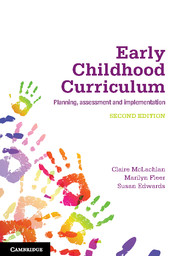Book contents
- Frontmatter
- Contents
- About the authors
- Acknowledgements
- 1 Introduction
- 2 Theory, research and the early childhood curriculum
- 3 Development and learning – how views of development shape how curriculum is framed
- 4 Curriculum as a cultural broker
- 5 Interpreting early childhood curriculum
- 6 Cultural-historical curriculum in action
- 7 Curriculum as a conceptual tool: Observation, content and programming
- 8 Assessing children and evaluating curriculum
- 9 Content knowledge: The sciences, maths and numeracy
- 10 Content knowledge: Language, literacy and ICT
- 11 Content knowledge: The arts and health, wellbeing and physical activity
- 12 Conclusions
- Glossary
- References
- Index
12 - Conclusions
- Frontmatter
- Contents
- About the authors
- Acknowledgements
- 1 Introduction
- 2 Theory, research and the early childhood curriculum
- 3 Development and learning – how views of development shape how curriculum is framed
- 4 Curriculum as a cultural broker
- 5 Interpreting early childhood curriculum
- 6 Cultural-historical curriculum in action
- 7 Curriculum as a conceptual tool: Observation, content and programming
- 8 Assessing children and evaluating curriculum
- 9 Content knowledge: The sciences, maths and numeracy
- 10 Content knowledge: Language, literacy and ICT
- 11 Content knowledge: The arts and health, wellbeing and physical activity
- 12 Conclusions
- Glossary
- References
- Index
Summary
Setting: A university tutorial room
Timing: The last class for the year
Participants: An international group of 3rd year BEd (Early Years) students and their lecturer
Subject: Curriculum in the early childhood setting
Lecturer: It seems incredible that we are finally at the end of the course! What I’d like to do today, as part of wrapping up this course and helping to prepare you for your new careers as teachers, is to check that you have a good understanding now of the term ‘curriculum’ and what it means in terms of your teaching practice. If you think back to the beginning of this course, I asked you to define what you understood by the term ‘curriculum’ and it was evident in that early discussion that as a group we had a range of different opinions about it and also quite a bit of confusion about what ‘curriculum’ might mean for us as teachers. We’ve spent a lot of time on this topic and we’ve looked at many aspects of it. Take about 15 minutes to discuss this now and then we will discuss it as a group. Get someone from your group to record your ideas, so that we can share them.
Students move off into groups of about six people and begin the task set by the lecturer.
Michael: I remember this activity – we were all over the place about what we thought a curriculum is.
Jacob: Yes, we were – and to be honest, I didn’t want to take this course, but it has been useful in terms of clarifying my thinking about curriculum.
Kiri: Yes, it has. I’ve realised now that the curriculum I’mused to using is similar in lots of ways to other curriculum documents, but it really represents the social, educational, political and economic aims each community or country has for their children.
Hui Lee: Yes, indeed – I can now think quite critically about my own curriculum and I am able to question some of the assumptions about children that underpin the curriculum used in Singapore. It’s good to be able to put the focus of the curriculum into a bigger context of what a curriculum is striving to achieve.
- Type
- Chapter
- Information
- Early Childhood CurriculumPlanning, Assessment, and Implementation, pp. 197 - 204Publisher: Cambridge University PressPrint publication year: 2013



